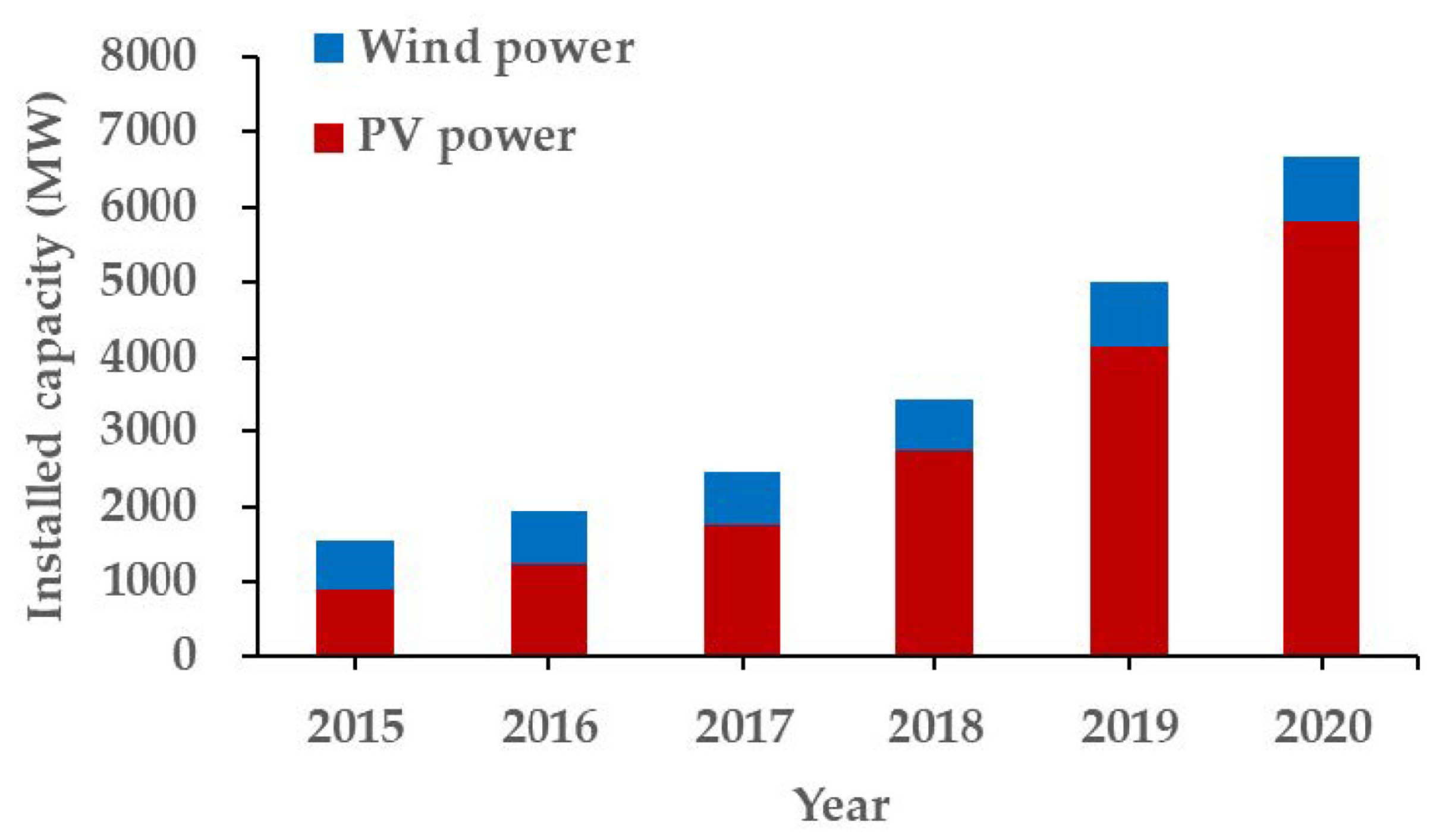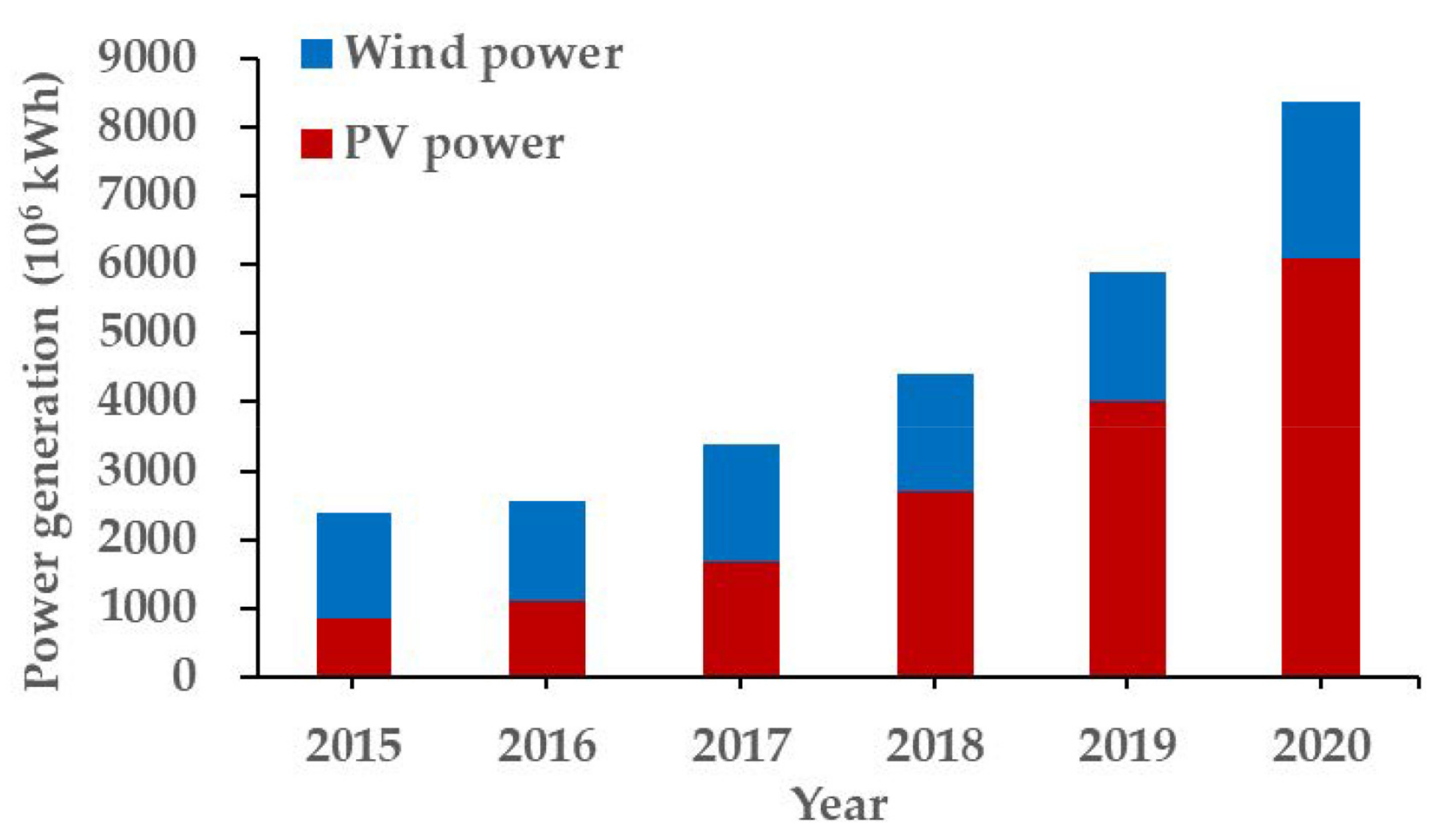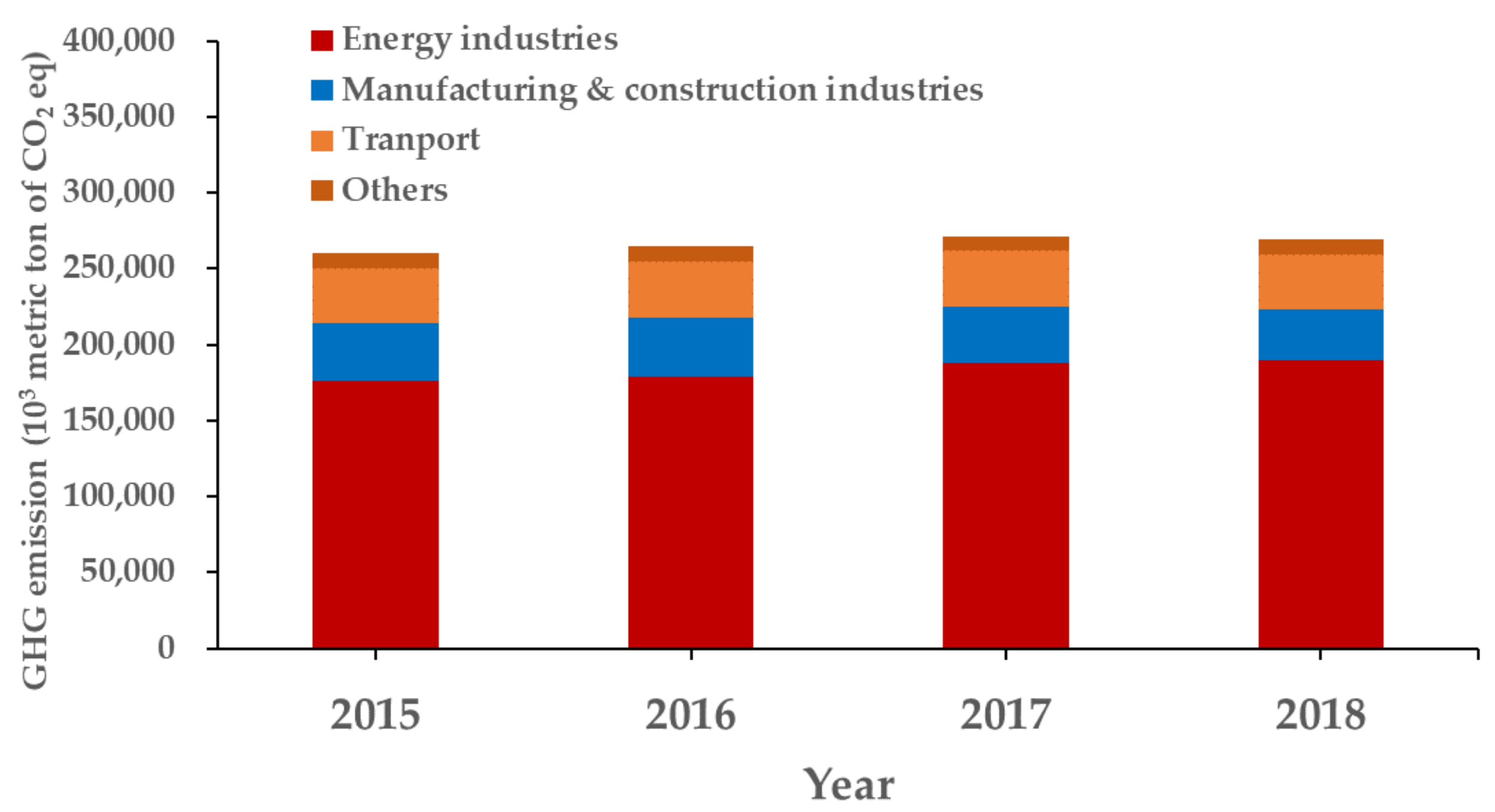Trend Analysis of Taiwan’s Greenhouse Gas Emissions from the Energy Sector and Its Mitigation Strategies and Promotion Actions
Abstract
1. Introduction
- -
- Trend analysis of Taiwan’s GHG emissions in the energy sector.
- -
- Regulatory system for mitigating the emissions of GHG from the energy sector.
- -
- Promotional actions for mitigating the emissions of GHG from the energy sector.
2. Data Mining and Methodology
3. Results and Discussion
3.1. Trend Analysis of Taiwan’s GHG Emission in the Energy Sector
3.1.1. Analysis of GHG Emission and Relevant Sustainability Indicators in Taiwan
3.1.2. Analysis of the Emissions of GHG from Various Sectors in Taiwan
3.1.3. Analysis of the Emissions of GHG from the Energy Sector in Taiwan
- -
- Energy industry
- -
- Manufacturing industry and construction
- -
- Transportation
- -
- Others (including other sectors and fugitive emissions from fuels)
3.2. Regulatory System for Mitigating the Emissions of GHG from the Energy Sector
3.2.1. Greenhouse Gas Reduction and Management Act (GGRMA)
- -
- The period of 2016–2020: 2% by 2020
- -
- The period of 2021–2025: 10% by 2025
- -
- The period of 2026–2030: 20% by 2030
- Energy sector
- -
- The total installed capacity of renewable energy will be higher than 31,000 Megawatt (MW).
- Industrial processes sector
- -
- Energy intensity or carbon intensity (the ratio of GHG emission to gross domestic product) will be reduced by 50%, compared to the 2005 level.
- Transportation sector: 37.2 million metric tons of CO2eq (MtCO2eq) (reduced by 2% in comparison with the 2005 level).
- -
- Public transport will grow more than 20% compared to that of 2015 level.
- -
- Official vehicles and city buses will be electrified totally.
- -
- Motorcycles with using new energy will account for 35% of new sales.
- Residential and commercial sector: 57.5 MtCO2eq (reduced by 2.5% in comparison with the 2005 level).
- -
- The electricity efficiency in the public sector buildings will improve by 10% and meet the announced specifications of the energy usage index (EUI).
- -
- It will be developed for the establishment of building the energy database and building the energy passport in 2030.
- Agriculture sector
- -
- Total organic and friendly farming land area will reach 30,000 hectares.
- -
- The biogas-to-power production by valorizing manure with about 375 × 104 heads swine ill reach 75% of total swine heads on farms.
- -
- The forest land area via afforestation and reforestation will reach 7080 hectares.
- Waste management sector
- -
- The national sewage treatment rate will reach 70%.
3.2.2. Energy Management Act (EMA)
- 1.
- The central competent authority (i.e., MOEA) should establish the regulation on the designation of energy users, types of energy consuming facilities (i.e., lighting, power, electric heating, air conditioning, refrigerating facilities), energy conservation and the efficiency of energy consumption.
- 2.
- The energy efficiency of the energy consuming facilities (or apparatus) and vehicles for domestic use designated by the central competent authority (i.e., MOEA) shall comply with the national standards of permissible energy consumption. These designated articles shall indicate the energy consumption and its efficiency.
- 3.
- In order to ensure the stable and safe supply of energy, as well as taking into consideration environmental impact and economic development, the central competent authority (i.e., MOEA) shall submit the National Energy Development Guidelines, which has been approved by the Executive Yuan for implementation in April 2017. Considering the balance between energy security, green economy, environmental sustainability and social equity, the development goal of the Guidelines was to achieve the nuclear-free homeland by 2025 and the energy sustainability.
3.2.3. Electricity Act
3.2.4. Renewable Energy Development Act (REDA)
- -
- The central and local government agencies have jointly cooperated to optimize the investment environment for achieving the promotion goal of renewable power generation with 27 GW in terms of accumulated installation capacity by 2025.
- -
- The Taiwan Power Company must open up the business model for the direct supply, grid connection and transfer of renewable electricity according to the Electricity Act 2017.
- -
- The Taiwan government will obligate large power users to set up the renewable power generation equipment to fulfill corporate social responsibilities (CSR). In order to promote the renewable energy, some measures, including the feed-in-tariff (FIT) mechanism, financial supports and funding subsidies, triggered the significant increase in the wind power and photovoltaic system in terms of installed capacity during the past two decades.
3.3. Promotional Actions for Mitigating the Emissions of GHG from the Energy Sector
3.3.1. Energy Efficiency (or Energy Saving)
Minimum Energy Performance Standards (MEPS)
Energy Audit and Conservation Consultation
Vehicle Fuel Economy Regulation
Energy Conservation Project for Governmental and Educational Institutions
New Power Saving Campaign Program
3.3.2. Renewable Energy Development
Four-Year (2017–2020) Plan of Promotion for Wind Power
- -
- Goals by 2020:
- -
- Goals by 2025:
Two-Year (2019–2020) Photovoltaic Power Promotion Program
- -
- Goals by 2019:
- -
- Goals by 2020:
4. Conclusions
Funding
Institutional Review Board Statement
Informed Consent Statement
Data Availability Statement
Conflicts of Interest
References
- Ministry of Economic Affairs (MOEA). Guidelines on Energy Development; MOEA: Taipei, Taiwan, 2007.
- Intergovernmental Panel on Climate Change (IPCC). 2006 IPCC Guidelines for National Greenhouse Gas Inventories; IPCC: Geneva, Switzerland, 2007. [Google Scholar]
- Environmental Protection Administration (EPA). Taiwan Greenhouse Gases Inventory; EPA: Taipei, Taiwan, 2020. [Google Scholar]
- Tsai, W.T. Energy sustainability from analysis of sustainable development indicators: A case study in Taiwan. Renew. Sustain. Energy Rev. 2010, 14, 2131–2138. [Google Scholar] [CrossRef]
- Qureitem, G.; Al-Khatib, I.A.; Anayah, F. Inventory of main greenhouse gas emissions from energy sector in Palestine. Environ. Monit. Assess. 2020, 192, 2020. [Google Scholar] [CrossRef]
- Siqueira, D.S.; de Almeida Meystre, J.; Hilario, M.Q.; Rocha, D.H.D.; Menon, G.J.; da Silva, R.J. Current perspectives on nuclear energy as a global climate change mitigation option. Mitig. Adapt. Strateg. Glob. Chang. 2019, 24, 749–777. [Google Scholar] [CrossRef]
- Fan, M.F. Risk discourses and governance of high-level radioactive waste storage in Taiwan. J. Environ. Plan. Manag. 2019, 62, 327–341. [Google Scholar] [CrossRef]
- Zysk, J.; Wyrwa, A.; Suwala, W.; Pluta, M.; Olkuski, T.; Raczynski, M. The impact of decarbonization scenarios on air quality and human health in Poland—Analysis of scenarios up to 2050. Atmosphere 2020, 11, 1222. [Google Scholar] [CrossRef]
- Ministry of Economic Affairs (MOEA). Energy Statistics Handbook; MOEA: Taipei, Taiwan, 2020.
- Energy Statistics Database (Ministry of Economic Affairs, Taiwan). Available online: http://www.esist.org.tw/database (accessed on 21 May 2021).
- Laws and Regulation Retrieving System (Ministry of Justice, Taiwan). Available online: https://law.moj.gov.tw/Eng/index.aspx (accessed on 13 May 2021).
- Chang, C.T.; Lee, H.C. Taiwan’s renewable energy strategy and energy-intensive industrial policy. Renew. Sustain. Energy Rev. 2016, 64, 456–465. [Google Scholar] [CrossRef]
- Wang, Q.; Hang, Y.; Zhou, P.; Wang, Y. Decoupling and attribution analysis of industrial carbon emissions in Taiwan. Energy 2016, 113, 728–738. [Google Scholar] [CrossRef]
- Chou, K.T.; Walther, D.; Liou, H.M. The conundrums of sustainability: Carbon emissions and electricity consumption in the electronics and petrochemical industries in Taiwan. Sustainability 2019, 11, 5664. [Google Scholar] [CrossRef]
- van Sluisveld, M.A.E.; Hof, A.F.; van Vuuren, D.P.; Boot, P.; Criqui, P.; Matthes, F.C.; Notenboom, J.; Pedersen, S.L.; Pfluger, B.; Watson, J. Low-carbon strategies towards 2050: Comparing ex-ante policy evaluation studies and national planning processes in Europe. Environ. Sci. Policy 2017, 78, 89–96. [Google Scholar] [CrossRef]
- Heal, G. Reflections—What would it take to reduce U.S. greenhouse gas emissions 80 percent by 2050? Rev. Environ. Econ. Policy 2017, 11, 319–335. [Google Scholar] [CrossRef][Green Version]
- Herran, D.S.; Fujimori, S.; Kainuma, M. Implications of Japan’s long term climate mitigation target and the relevance of uncertain nuclear policy. Climate Policy 2019, 19, 1117–1131. [Google Scholar] [CrossRef]
- Council for Sustainable Development (CSD). Annual Review Report on the Taiwan’s Sustainable Development Goals; Environmental Protection Administration: Taipei, Taiwan, 2019. (In Chinese) [Google Scholar]
- Hennessey, R.; Pittman, J.; Morand, A.; Douglas, A. Co-benefits of integrating climate change adaptation and mitigation in the Canadian energy sector. Energy Policy 2017, 111, 214–221. [Google Scholar] [CrossRef]
- Iacobuta, G.; Dubash, N.K.; Upadhyaya, P.; Deribe, M.; Hohne, N. National climate change mitigation legislation, strategy and targets: A global update. Clim. Policy 2018, 18, 1114–1132. [Google Scholar] [CrossRef]
- Bastida, L.; Cohen, J.J.; Kollmann, A.; Moya, A.; Reichi, J. Exploring the role of ICT on household behavioural energy efficiency to mitigate global warming. Renew. Sustain. Energy Rev. 2019, 103, 455–462. [Google Scholar] [CrossRef]
- Gielen, D.; Boshell, F.; Saygin, D.; Bazilian, M.D.; Wagner, N.; Gorini, R. The role of renewable energy in the global energy transformation. Energy Strategy Rev. 2019, 24, 38–50. [Google Scholar] [CrossRef]
- Mi, Z.; Guan, D.; Liu, Z.; Liu, J.; Viguie, V.; Fromer, N.; Wang, Y. Cities: The core of climate change mitigation. J. Clean. Prod. 2019, 207, 582–589. [Google Scholar] [CrossRef]
- Streimikiene, D.; Balezentis, T.; Alisauskaite-Seskiene, I.; Stankuniene, G.; Simanaviciene, Z. A review of willingness to pay studies for climate change mitigation in the energy sector. Energies 2019, 12, 1481. [Google Scholar] [CrossRef]
- Yang, M.; Yu, X. Energy efficiency to mitigate carbon emissions: Strategies of China and the USA. Mitig. Adapt. Strateg. Glob. Change 2017, 22, 1–14. [Google Scholar] [CrossRef]
- Lu, S.M. A low-carbon transport infrastructure in Taiwan based on the implementation of energy-saving measures. Renew. Sustain. Energy Rev. 2016, 58, 499–509. [Google Scholar] [CrossRef]
- Kung, C.C.; McCarl, B.A. The potential role of renewable electricity generation in Taiwan. Energy Policy 2020, 138, 111227. [Google Scholar] [CrossRef]
- Eroglu, H. Effects of Covid-19 outbreak on environment and renewable energy sector. Environ. Dev. Sustain. 2021, 23, 782–4790. [Google Scholar] [CrossRef] [PubMed]



| GHG | Year | ||||||||
|---|---|---|---|---|---|---|---|---|---|
| 1990 | 1995 | 2000 | 2005 | 2010 | 2015 | 2016 | 2017 | 2018 | |
| Carbon dioxide (CO2) | 109,459 | 150,803 | 209,205 | 247,956 | 251,708 | 258,476 | 262,982 | 269,462 | 269,129 |
| Methane (CH4) | 530 | 533 | 574 | 631 | 631 | 710 | 730 | 738 | 721 |
| Nitrous oxide (N2O) | 537 | 778 | 1052 | 1269 | 1248 | 1242 | 1264 | 1276 | 1257 |
| Total emission | 110,526 | 152,114 | 210,831 | 249,856 | 253,587 | 260,428 | 264,976 | 271,476 | 271,107 |
| Energy Efficiency Indicator | Year | ||||||||
|---|---|---|---|---|---|---|---|---|---|
| 2000 | 2005 | 2010 | 2015 | 2016 | 2017 | 2018 | 2019 | 2020 | |
| Energy consumption per capita (LOE) 2 | 2766.4 | 3380.8 | 3629.9 | 3665.9 | 3682.2 | 3652.9 | 3713.7 | 3598.4 | 3619.4 |
| Electricity consumption per capita (kWh) 2 | 7978.6 | 9611.1 | 10,259.1 | 10,655.9 | 10,861.6 | 11,097.0 | 11,304.8 | 11,255.6 | 11,494.4 |
| Energy intensity (LOE/NT 1000) 3 | 6.21 | 6.38 | 5.64 | 5.01 | 4.93 | 4.74 | 4.70 | 4.42 | 4.31 |
| Energy productivity (NT/LOE) | 161.15 | 156.81 | 177.26 | 199.77 | 202.74 | 210.80 | 212.88 | 226.06 | 231.85 |
| Energy Indicator | Year | ||||||||
|---|---|---|---|---|---|---|---|---|---|
| 2000 | 2005 | 2010 | 2015 | 2016 | 2017 | 2018 | 2019 | 2020 | |
| RE supply ratio (%) 2 | 1.43 | 1.56 | 1.62 | 1.72 | 1.82 | 1.76 | 1.78 | 1.95 | 2.06 |
| RE power generation ratio (%) 3 | 3.45 | 3.28 | 3.50 | 4.07 | 4.83 | 4.58 | 4.59 | 5.60 | 5.40 |
| CO2 emissions per capita (metric ton) | 9.46 | 10.84 | 10.81 | 11.02 | 11.18 | 11.44 | 11.33 | 10.96 | 11.02 5 |
| CO2 emissions intensity (kg CO2/NT 1000) 4 | 22.21 | 20.58 | 16.90 | 15.04 | 14.98 | 14.86 | 14.34 | 13.52 | 13.19 5 |
| Renewable Energy Supply | Year | ||||||||
|---|---|---|---|---|---|---|---|---|---|
| 2000 | 2005 | 2010 | 2015 | 2016 | 2017 | 2018 | 2019 | 2020 | |
| Total installed capacity of RE (MW) 2 | 2262.56 | 2607.97 | 3197.12 | 4329.53 | 4725.74 | 5258.68 | 6246.34 | 7795.20 | 9474.44 |
| Installed capacity of PV power (MW) | 0.10 | 1.04 | 34.56 | 888.25 | 1245.06 | 1767.70 | 2738.12 | 4149.54 | 5817.20 |
| Installed capacity of wind power (MW) | 2.64 | 23.94 | 475.59 | 646.69 | 682.09 | 692.39 | 703.99 | 845.20 | 853.70 |
| Installed capacity of onshore wind power (MW) | 2.64 | 23.94 | 475.59 | 646.69 | 682.09 | 684.39 | 695.99 | 717.20 | 725.70 |
| Installed capacity of offshore wind power (MW) | 0 3 | 0 | 0 | 0 | 0 | 8 | 8 | 128 | 128 |
| Renewable Energy Supply | Year | ||||||||
|---|---|---|---|---|---|---|---|---|---|
| 2000 | 2005 | 2010 | 2015 | 2016 | 2017 | 2018 | 2019 | 2020 | |
| Total RE power generation 2 (106 kWh) | 6370.9 | 7537.3 | 8638.0 | 10,476.0 | 12,730.1 | 12,365.4 | 12,648.5 | 15,247.4 | 15,119.8 |
| PV power generation (106 kWh) | 0.1 | 1.0 | 21.9 | 850.3 | 1109.0 | 1667.5 | 2712.0 | 4014.3 | 6085.8 |
| Total wind power generation (106 kWh) | 1.4 | 91.3 | 1026.3 | 1525.2 | 1457.1 | 1722.5 | 1706.8 | 1892.2 | 2289.3 |
| Onshore wind power generation (106 kWh) | 1.4 | 91.3 | 1026.3 | 1,25.2 | 1457.1 | 1702.1 | 1659.2 | 1715.8 | 1768.6 |
| Offshore wind power generation (106 kWh) | 0 3 | 0 | 0 | 0 | 0 | 20.4 | 26.7 | 176.4 | 520.7 |
| Sector | Year | ||||||||
|---|---|---|---|---|---|---|---|---|---|
| 1990 | 1995 | 2000 | 2005 | 2010 | 2015 | 2016 | 2017 | 2018 | |
| Energy | 110,525 | 152,115 | 210,831 | 249,856 | 253,588 | 260,428 | 264,977 | 271,475 | 269,106 |
| IPPU 2 | 14,616 | 18,677 | 20,484 | 29,398 | 25,296 | 23,336 | 22,682 | 21,456 | 21,979 |
| AFOLU 3 | −19,340 | −19,243 | −18,833 | −18,791 | −18,482 | −18,646 | −18,7665 | −18,749 | −18,798 |
| Waste | 7571 | 10,007 | 10,045 | 7327 | 4423 | 2886 | 2804 | 2724 | 2752 |
| Net | 113,373 | 161,556 | 222,527 | 267,790 | 264,824 | 268,004 | 271,799 | 276,906 | 275,039 |
| (Total) | (136,759) | (184,789) | (245,003) | (289,708) | (286,237) | (289,429) | (293,250) | (298,388) | (296,546) |
| Source | Year | ||||||||
|---|---|---|---|---|---|---|---|---|---|
| 1990 | 1995 | 2000 | 2005 | 2010 | 2015 | 2016 | 2017 | 2018 | |
| Energy industries | 49,287 | 76,680 | 121,637 | 157,019 | 166,211 | 175,874 | 179,256 | 187,850 | 189,939 |
| Manufacturing & construction industries | 30,253 | 35,922 | 44,137 | 42,886 | 41,569 | 38,270 | 38,500 | 36,933 | 33,563 |
| Transport | 20,089 | 29,468 | 33,952 | 37,676 | 35,433 | 36,311 | 37,412 | 37,018 | 36,003 |
| Others 2 | 10,896 | 10,045 | 11,105 | 12,275 | 10,374 | 9963 | 9809 | 9675 | 9602 |
| Total | 110,525 | 152,115 | 210,831 | 249,856 | 253,587 | 260,428 | 264,977 | 271,475 | 269,106 |
| Law/Act a | GGRMA | EMA | EA | REDA |
|---|---|---|---|---|
| Year of first promulgation | 2015 | 1980 | 1947 | 2009 |
| Year of recent revision | -- | 2016 | 2019 | 2019 |
| Central competent authority b | EPA | MOEA | MOEA | MOEA |
| Relevant issues and measures | GHG emission mitigation and adaptation | Energy use saving and efficiency auditing | Green electricity grid service and market opening | Green energy development and promotion |
Publisher’s Note: MDPI stays neutral with regard to jurisdictional claims in published maps and institutional affiliations. |
© 2021 by the author. Licensee MDPI, Basel, Switzerland. This article is an open access article distributed under the terms and conditions of the Creative Commons Attribution (CC BY) license (https://creativecommons.org/licenses/by/4.0/).
Share and Cite
Tsai, W.-T. Trend Analysis of Taiwan’s Greenhouse Gas Emissions from the Energy Sector and Its Mitigation Strategies and Promotion Actions. Atmosphere 2021, 12, 859. https://doi.org/10.3390/atmos12070859
Tsai W-T. Trend Analysis of Taiwan’s Greenhouse Gas Emissions from the Energy Sector and Its Mitigation Strategies and Promotion Actions. Atmosphere. 2021; 12(7):859. https://doi.org/10.3390/atmos12070859
Chicago/Turabian StyleTsai, Wen-Tien. 2021. "Trend Analysis of Taiwan’s Greenhouse Gas Emissions from the Energy Sector and Its Mitigation Strategies and Promotion Actions" Atmosphere 12, no. 7: 859. https://doi.org/10.3390/atmos12070859
APA StyleTsai, W.-T. (2021). Trend Analysis of Taiwan’s Greenhouse Gas Emissions from the Energy Sector and Its Mitigation Strategies and Promotion Actions. Atmosphere, 12(7), 859. https://doi.org/10.3390/atmos12070859





